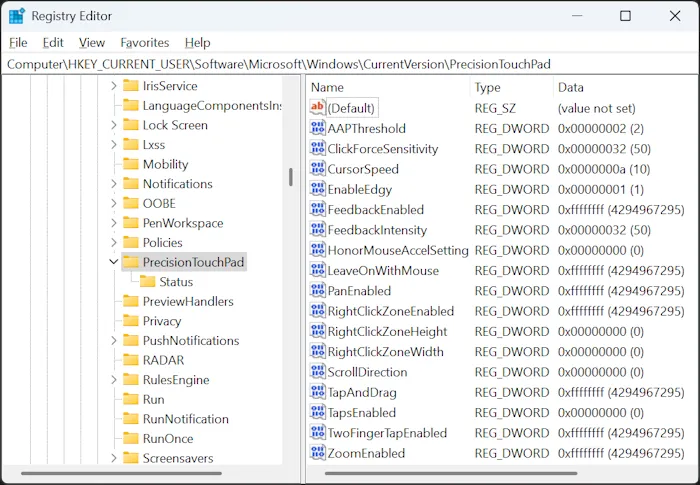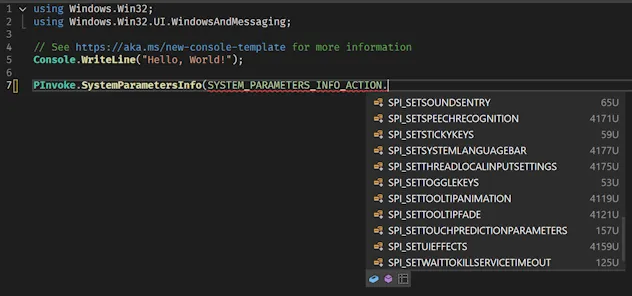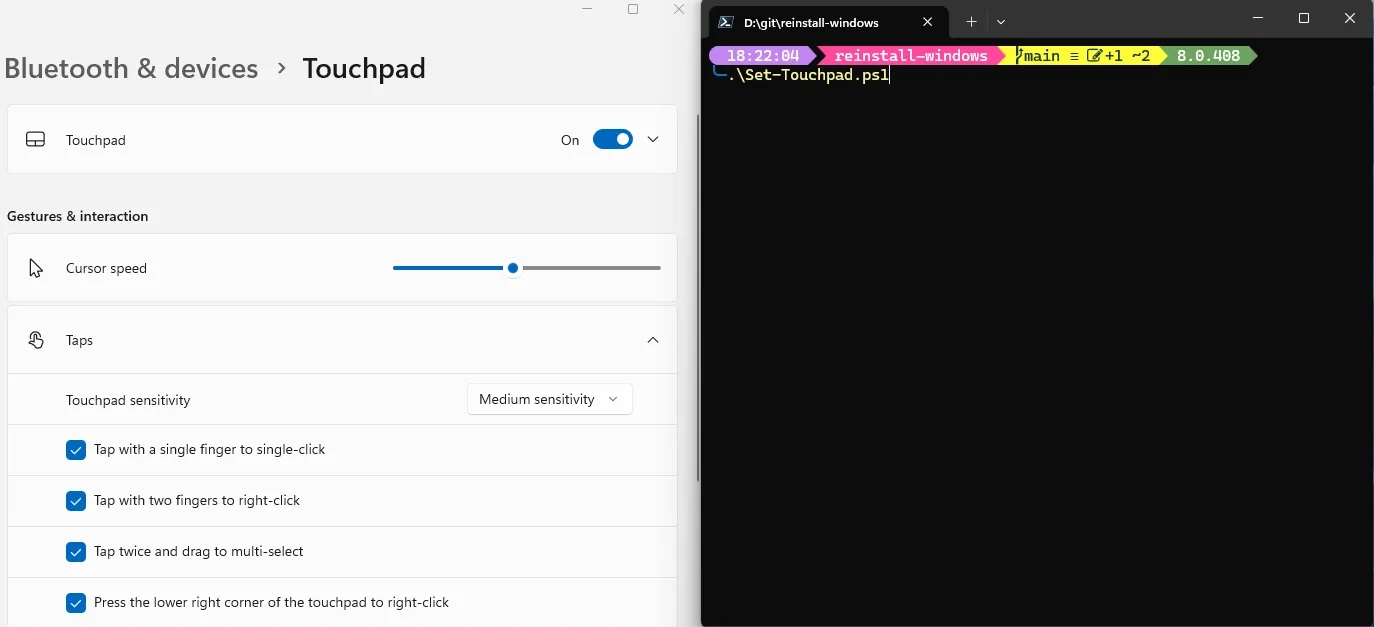Changing the Windows touchpad settings programmatically
Now that I’ve got a reliable process for reinstalling Windows, I do have a list of things that I’d like to automate to get it configured “just right”. As such, I’ve created a new repository on GitHub and added issues to track each one of these. While my Boxstarter scripts will remain for now as GitHub Gists, I think it’s going to be easier to manage all of these things together in the one Git repository.
One customisation I like to make to Windows is to disable the ‘Tap with a single finger to single-click’ for the touchpad. I find I’m less likely to accidentally click on something when I was just tapping the touch pad to move the cursor if I turn this off.

I found some online articles that suggested this was managed by the Registry setting HKEY_CURRENT_USER\Software\Microsoft\Windows\CurrentVersion\PrecisionTouchPad. Experimenting with this seems to be partly true. I can see the Registry value TapsEnabled is updated when I enable or disable the checkbox in Windows Settings. But the reverse did not seem to be true - if I modified the Registry key, Windows Settings doesn’t change, nor does the touchpad behaviour.

Further searching lead me to the Tuning Guidelines page of the Windows Hardware Precision Touchpad Implementation Guide. I’m no hardware manufacturer, but this does document the TapsEnabled setting. Interestinly, down the bottom of that page it does also mention:
As of Windows 11, build 26027, the user’s touchpad settings can be queried and modified dynamically via the SystemParametersInfo API
I’m running Windows 11 24H2, which is build 26100, so that ‘SystemParametersInfo’ API should be available to me. Let’s see if calling that does the trick.
My C/C++ is pretty rusty, whereas I’m quite at home in C# or PowerShell. My preference would be to use .NET P/Invoke to call the Windows API.
As I’ve learned from previous times using P/Invoke, The trick to getting it working properly is to make sure you have the method signature(s) and data structures correct.
While my final goal is to call this from a PowerShell script, prototyping in a simple .NET console application should allow me to quickly test my definitions, plus get C# syntax highlighting and code completion within my IDE.
Let’s try and find an existing definition of SystemParametersInfo. I searched for ”.NET PInvoke” and noticed https://github.com/dotnet/pinvoke, but that repository is archived and you are instead pointed to https://github.com/microsoft/CsWin32. This project provides a .NET source generator that will create Win32 P/Invoke methods for you, based off of the latest metadata from the Windows team. That sounds perfect!
As per the documentation, I added a package reference
dotnet add package Microsoft.Windows.CsWin32Then created a NativeMethods.txt file and added SystemParametersInfo to it.
I then edited Program.cs and tried to use my new method:

Except SPI_GETTOUCHPADPARAMETERS isn’t available!
The documentation suggested you can get newer metadata for the source generator to use by adding a reference to the latest prerelease Microsoft.Windows.SDK.Win32Metadata package. I tried that, but still no joy. I’ve raised an issue in the microsoft/win32metadata repo, but for now it looks like I’ll need to hand-roll a few of the types myself.
The docs for SPI_GETTOUCHPADPARAMETERS say the following:
- The
pvParamparameter must point to aTOUCHPAD_PARAMETERSstructure. - The
uiParamparameter must specify the size of the structure. - The value of the
versionNumberfield in theTOUCHPAD_PARAMETERSstructure must be set to the appropriate value for the version of the structure being used.
The TOUCHPAD_PARAMETERS structure is documented using C++. I asked GitHub Copilot if it could translate that into equivalent C# for me. It came up with this:
// DO NOT USE THIS - IT IS INCORRECT!!
[StructLayout(LayoutKind.Sequential)]
public struct TOUCHPAD_PARAMETERS
{
public uint VersionNumber;
public uint MaxSupportedContacts;
public LEGACY_TOUCHPAD_FEATURES LegacyTouchpadFeatures;
// Bit fields are represented as individual boolean fields in C#
public bool TouchpadPresent;
public bool LegacyTouchpadPresent;
public bool ExternalMousePresent;
public bool TouchpadEnabled;
public bool TouchpadActive;
public bool FeedbackSupported;
public bool ClickForceSupported;
[MarshalAs(UnmanagedType.ByValArray, SizeConst = 25)]
public bool[] Reserved1;
public bool AllowActiveWhenMousePresent;
public bool FeedbackEnabled;
public bool TapEnabled;
public bool TapAndDragEnabled;
public bool TwoFingerTapEnabled;
public bool RightClickZoneEnabled;
public bool MouseAccelSettingHonored;
public bool PanEnabled;
public bool ZoomEnabled;
public bool ScrollDirectionReversed;
[MarshalAs(UnmanagedType.ByValArray, SizeConst = 22)]
public bool[] Reserved2;
public TOUCHPAD_SENSITIVITY_LEVEL SensitivityLevel;
public uint CursorSpeed;
public uint FeedbackIntensity;
public uint ClickForceSensitivity;
public uint RightClickZoneWidth;
public uint RightClickZoneHeight;
}And likewise for the two enums LEGACY_TOUCHPAD_FEATURES enumeration and TOUCHPAD_SENSITIVITY_LEVEL enumeration.
One thing you need to do is set the VersionNumber property to TOUCHPAD_PARAMETERS_LATEST_VERSION. Except I searched to find out what the value of that is, and no results. I ended up resorting to installing the Windows 11 SDK so I could locate WinUser.h and then I found this:
#define TOUCHPAD_PARAMETERS_LATEST_VERSION 1
#define TOUCHPAD_PARAMETERS_VERSION_1 1But then trying to call SystemParametersInfo was not working. That lead me down a bit of a rabbit hole to finally conclude that something is still wrong with the mapping in TOUCHPAD_PARAMETERS. The original structure in C++ is this:
typedef struct TOUCHPAD_PARAMETERS {
UINT versionNumber;
UINT maxSupportedContacts;
LEGACY_TOUCHPAD_FEATURES legacyTouchpadFeatures;
BOOL touchpadPresent : 1;
BOOL legacyTouchpadPresent : 1;
BOOL externalMousePresent : 1;
BOOL touchpadEnabled : 1;
BOOL touchpadActive : 1;
BOOL feedbackSupported : 1;
BOOL clickForceSupported : 1;
BOOL Reserved1 : 25;
BOOL allowActiveWhenMousePresent : 1;
BOOL feedbackEnabled : 1;
BOOL tapEnabled : 1;
BOOL tapAndDragEnabled : 1;
BOOL twoFingerTapEnabled : 1;
BOOL rightClickZoneEnabled : 1;
BOOL mouseAccelSettingHonored : 1;
BOOL panEnabled : 1;
BOOL zoomEnabled : 1;
BOOL scrollDirectionReversed : 1;
BOOL Reserved2 : 22;
TOUCHPAD_SENSITIVITY_LEVEL sensitivityLevel;
UINT cursorSpeed;
UINT feedbackIntensity;
UINT clickForceSensitivity;
UINT rightClickZoneWidth;
UINT rightClickZoneHeight;
} TOUCHPAD_PARAMETERS, *PTOUCH_PAD_PARAMETERS, TOUCHPAD_PARAMETERS_V1, *PTOUCHPAD_PARAMETERS_V1;Notice all those numbers after many of the fields? Those indicate it is a C bit field. And guess what feature C# doesn’t currently support?
In that discussion though there is a suggestion that you can use BitVector32 or BitArray as a workaround. For usability, we can add properties in to expose access to the individual bits in the BitVector32 field. Also note that the values passed in via the [] is a bitmask, not an array index. (Yes, that tricked me the first time too!)
[StructLayout(LayoutKind.Sequential)]
public struct TOUCHPAD_PARAMETERS
{
public uint VersionNumber;
public uint MaxSupportedContacts;
public LEGACY_TOUCHPAD_FEATURES LegacyTouchpadFeatures;
private BitVector32 First;
public bool TouchpadPresent
{
get => First[1];
set => First[1] = value;
}
public bool LegacyTouchpadPresent
{
get => First[2];
set => First[2] = value;
}With that done, we can now call SystemParametersInfo like this:
const uint SPI_GETTOUCHPADPARAMETERS = 0x00AE;
unsafe
{
TOUCHPAD_PARAMETERS param;
param.VersionNumber = 1;
var size = (uint)Marshal.SizeOf<TOUCHPAD_PARAMETERS>();
var result = PInvoke.SystemParametersInfo((SYSTEM_PARAMETERS_INFO_ACTION)SPI_GETTOUCHPADPARAMETERS,
size, ¶m, 0);And it works! Now curiously, the Windows Settings page doesn’t update in real time, but if you go to a different page and then navigate back to the Touchpad page, the setting has updated!
We can refactor the code slightly to put it into a helper static class, so it’s easier to call from PowerShell. To make this easier I created a second Console application, but this time I didn’t add any source generators, so I would be forced to ensure that all required code was available You can view the source code here.
I could then copy the C# into a PowerShell script and use the Add-Type command to include it in the current PowerShell session. Note the use of -CompilerOptions "/unsafe", which we need to specify as we’re using the unsafe keyword in our C# code.
$source=@'
using System;
using System.Collections.Specialized;
using System.Runtime.InteropServices;
using System.Runtime.Versioning;
public static class SystemParametersInfoHelper
{
[DllImport("USER32.dll", ExactSpelling = true, EntryPoint = "SystemParametersInfoW", SetLastError = true), DefaultDllImportSearchPaths(DllImportSearchPath.System32)]
[SupportedOSPlatform("windows5.0")]
internal static extern unsafe bool SystemParametersInfo(uint uiAction, uint uiParam, [Optional] void* pvParam, uint fWinIni);
public static void DisableSingleTap()
{
const uint SPI_GETTOUCHPADPARAMETERS = 0x00AE;
const uint SPI_SETTOUCHPADPARAMETERS = 0x00AF;
unsafe
{
// Use a fixed buffer to handle the managed type issue
TOUCHPAD_PARAMETERS param;
param.VersionNumber = 1;
var size = (uint)Marshal.SizeOf<TOUCHPAD_PARAMETERS>();
var result = SystemParametersInfo(SPI_GETTOUCHPADPARAMETERS, size, ¶m, 0);
if (param.TapEnabled)
{
param.TapEnabled = false;
result = SystemParametersInfo(SPI_SETTOUCHPADPARAMETERS, size, ¶m, 3);
}
}
}
}
[StructLayout(LayoutKind.Sequential)]
public struct TOUCHPAD_PARAMETERS
{
...
'@
Add-Type -TypeDefinition $source -Language CSharp -PassThru -CompilerOptions "/unsafe" | Out-Null
[SystemParametersInfoHelper]::DisableSingleTap()The complete version of the script is available here.

That’s one problem solved. Just a few more to go!